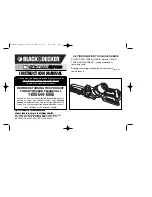
20
Make sure that the pointer points to 0° on the miter
scale. If the pointer does not point to 0°, loosen the
screw which secures the pointer and adjust the pointer
so that it will point to 0°.
2. Bevel angle
(1) 0° bevel angle
(Fig. 51)
Push the carriage toward the guide fence and
tighten the locking screw to secure the carriage.
Lower the handle fully and lock it in the lowered
position by pushing in the stopper pin. Loosen the
lever at the rear of the tool.
(Fig. 52)
Turn the hex bolt on the right side of the arm two
or three revolutions counterclockwise to tilt the
blade to the right.
(Fig. 53)
Carefully square the side of the blade with the top
surface of the turn base using the triangular rule,
try-square, etc. by turning the hex bolt on the right
side of the arm clockwise. Then tighten the lever
securely.
(Fig. 54)
Make sure that the pointer on the arm point to 0°
on the bevel scale on the arm holder. If they do not
point to 0°, loosen the screw which secure the
pointer and adjust it so that it will point to 0°.
(2) 45° bevel angle
(Fig. 55)
Adjust the 45° bevel angle only after performing 0°
bevel angle adjustment. To adjust left 45° bevel
angle, loosen the lever and tilt the blade to the left
fully. Make sure that the pointer on the arm points
to 45° on the bevel scale on the arm holder. If the
pointer does not point to 45°, turn the 45° bevel
angle adjusting bolt on the right side of the arm
holder until the pointer points to 45°.
To adjust the right 5° bevel angle, perform the
same procedure as that described above.
Replacing carbon brushes (Fig. 56)
Remove and check the carbon brushes regularly. Replace
when they wear down to 3 mm in length. Keep the carbon
brushes clean and free to slip in the holders. Both carbon
brushes should be replaced at the same time. Use only
identical carbon brushes.
(Fig. 57)
Use a screwdriver to remove the brush holder caps. Take
out the worn carbon brushes, insert the new ones and
secure the brush holder caps.
After use
• After use, wipe off chips and dust adhering to the tool
with a cloth or the like. Keep the blade guard clean
according to the directions in the previously covered
section titled “Blade guard”. Lubricate the sliding
portions with machine oil to prevent rust.
• When storing the tool, pull the carriage toward you
fully.
To maintain product SAFETY and RELIABILITY, repairs,
any other maintenance or adjustment should be
performed by Makita Authorized Service Centers, always
using Makita replacement parts.
ACCESSORIES
WARNING:
•
These Makita accessories or attachments are
recommended for use with your Makita tool
specified in this manual.
The use of any other
accessories or attachments may result in serious
personal injury.
•
Only use the Makita accessory or attachment for its
stated purpose.
Misuse of an accessory or
attachment may result in serious personal injury.
If you need any assistance for more details regarding
these accessories, ask your local Makita Service Center.
• Steel & Carbide-tipped saw blades
• Vise assembly (Horizontal vise)
• Vertical vise
• Socket wrench with hex wrench on its other end
• Holder
• Dust bag
• Elbow
• Triangular rule
Noise
ENG905-1
The typical A-weighted noise level determined according
to EN61029:
Sound pressure level (L
pA
): 97 dB (A)
Sound power level (L
WA
): 103 dB (A)
Uncertainty (K): 3 dB (A)
Wear ear protection.
Vibration
ENG900-1
The vibration total value (tri-axial vector sum) determined
according to EN61029:
Vibration emission (a
h
): 2.5 m/s
2
or less
Uncertainty (K): 1.5 m/s
2
ENG901-1
• The declared vibration emission value has been
measured in accordance with the standard test method
and may be used for comparing one tool with another.
• The declared vibration emission value may also be
used in a preliminary assessment of exposure.
WARNING:
• The vibration emission during actual use of the power
tool can differ from the declared emission value
depending on the ways in which the tool is used.
• Be sure to identify safety measures to protect the
operator that are based on an estimation of exposure in
the actual conditions of use (taking account of all parts
of the operating cycle such as the times when the tool
is switched off and when it is running idle in addition to
the trigger time).
Miter saw blades
For smooth and precise cutting in
various materials.
Combination
General purpose blade for fast and
smooth rip, crosscuts and miters.
Crosscutting
For smoother cross grain cuts. Slices
cleanly against the grain.
Fine cross cuts
For sand-free cuts cleanly against the
grain.
Non-ferrous
metals miter saw
blades
For miters in aluminum, copper,
brass, tubing, and other non-ferrous
metals.
Содержание LS1017
Страница 2: ...2 1 2 3 4 5 6 7 8 1 2 2 3 3 4 5 6 7 4 8 9 10 11 13 12 14 ...
Страница 3: ...3 9 10 11 12 13 14 15 16 15 16 17 18 19 20 21 21 22 18 23 21 18 24 23 25 26 21 27 28 ...
Страница 4: ...4 17 18 19 20 21 22 23 24 26 27 28 29 30 31 32 33 1 34 35 36 37 3 ...
Страница 6: ...6 33 34 35 36 37 38 51 52 53 5 14 54 55 52 56 25 57 ...
Страница 8: ...8 47 48 49 50 51 52 53 54 14 69 20 14 70 5 18 17 21 22 71 72 70 6 12 5 18 23 ...
Страница 9: ...9 55 56 57 73 72 74 75 ...
Страница 119: ...119 ...
Страница 120: ...ALA Makita Corporation Anjo Aichi Japan JM2318A026 www makita com ...
















































